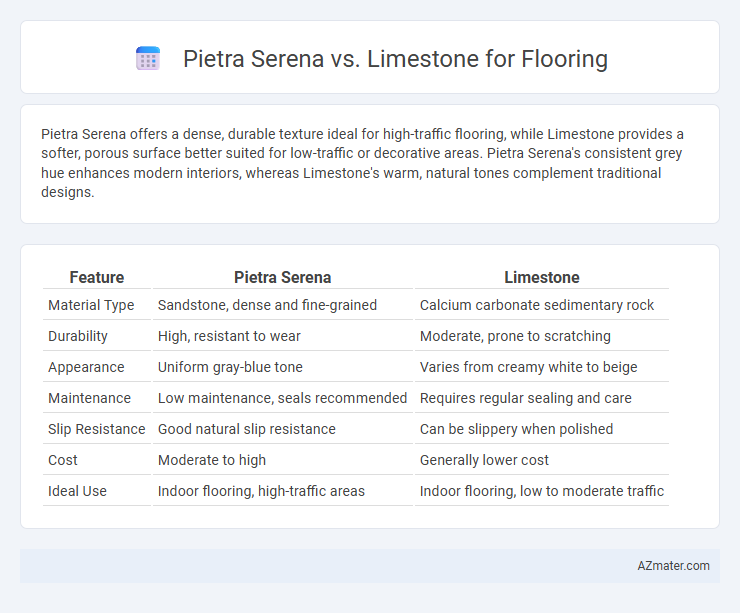Pietra Serena offers a dense, durable texture ideal for high-traffic flooring, while Limestone provides a softer, porous surface better suited for low-traffic or decorative areas. Pietra Serena's consistent grey hue enhances modern interiors, whereas Limestone's warm, natural tones complement traditional designs.
Table of Comparison
| Feature | Pietra Serena | Limestone |
|---|---|---|
| Material Type | Sandstone, dense and fine-grained | Calcium carbonate sedimentary rock |
| Durability | High, resistant to wear | Moderate, prone to scratching |
| Appearance | Uniform gray-blue tone | Varies from creamy white to beige |
| Maintenance | Low maintenance, seals recommended | Requires regular sealing and care |
| Slip Resistance | Good natural slip resistance | Can be slippery when polished |
| Cost | Moderate to high | Generally lower cost |
| Ideal Use | Indoor flooring, high-traffic areas | Indoor flooring, low to moderate traffic |
Introduction to Pietra Serena and Limestone Flooring
Pietra Serena is a dense, fine-grained sandstone known for its gray-blue hue and durability, making it a popular choice for sophisticated flooring with a unique, elegant appearance. Limestone flooring offers a softer, often creamy or beige tone, prized for its natural texture and versatility in both traditional and modern interiors. Both materials provide distinct aesthetic and functional benefits, with Pietra Serena favored for its strength and limestone valued for its warm, inviting ambiance.
Geological Origins and Composition
Pietra Serena is a dense, fine-grained sandstone primarily composed of quartz and feldspar, formed during the Oligocene epoch in Tuscany, Italy, known for its uniform bluish-gray hue and durability. Limestone, mainly composed of calcite derived from marine organisms' skeletal fragments, often forms in warm, shallow marine environments, displaying a wider range of colors and softer texture compared to Pietra Serena. The geological origins influence their physical properties, with Pietra Serena offering greater hardness and weather resistance, while limestone presents more porous characteristics affecting its suitability for high-traffic flooring.
Aesthetic Differences and Visual Appeal
Pietra Serena flooring offers a rich gray-blue tone with subtle veining that creates a sophisticated, modern aesthetic, while limestone showcases warmer, earthy hues ranging from cream to beige, lending a classic and rustic charm. The smooth, matte finish of Pietra Serena provides a sleek, contemporary look ideal for minimalist interiors, whereas limestone's natural texture and soft color variations add depth and timeless elegance to traditional or Mediterranean designs. Visual appeal varies as Pietra Serena brings cool, uniformity and urban refinement, contrasting limestone's inviting warmth and organic irregularities that highlight natural beauty.
Durability and Longevity
Pietra Serena is a dense, fine-grained sandstone known for its exceptional durability and resistance to wear, making it ideal for high-traffic flooring areas. Limestone, while aesthetically versatile, tends to be softer and more porous, which can result in increased susceptibility to scratching and weathering over time. For flooring applications demanding long-term resilience, Pietra Serena generally outperforms limestone due to its compact structure and lower absorption rate.
Slip Resistance and Surface Texture
Pietra Serena offers a honed surface with a fine-grain texture that enhances slip resistance, making it suitable for residential and commercial flooring where safety is a priority. Limestone typically has a softer, more porous surface that can become slippery when wet unless treated with anti-slip coatings or textured finishes. The durability and natural roughness of Pietra Serena provide better traction compared to the smoother, often polished limestone floors.
Maintenance and Cleaning Requirements
Pietra Serena flooring requires minimal maintenance due to its natural density and resistance to water absorption, making it easier to clean with regular sweeping and occasional damp mopping using neutral pH cleaners. Limestone, being more porous and softer, demands more frequent sealing to prevent staining and damage from spills, along with gentle cleaning methods that avoid abrasive chemicals. Both materials benefit from prompt spill cleanup, but Pietra Serena offers greater durability and lower upkeep costs over time.
Environmental Impact and Sustainability
Pietra Serena, a durable volcanic sandstone, offers a lower environmental footprint compared to limestone due to its natural abundance and minimal processing requirements, reducing energy consumption during extraction and finishing. Limestone extraction and processing involve higher carbon emissions, primarily from quarrying and the calcination process, contributing significantly to greenhouse gas emissions. Choosing Pietra Serena supports sustainable flooring with longer lifespan and less environmental degradation, aligning with eco-friendly building practices.
Cost Comparison and Value
Pietra Serena offers a mid-range cost for flooring, generally priced between $15 to $30 per square foot, while limestone varies widely from $10 to $40 per square foot depending on quality and origin. The dense composition and durability of Pietra Serena provide excellent long-term value through resistance to wear and minimal maintenance, whereas limestone, being softer and more porous, may incur higher upkeep costs over time. Choosing between the two depends on balancing initial investment with expected lifespan and maintenance expenses to achieve optimal flooring value.
Popular Applications in Interior Design
Pietra Serena, a gray sandstone known for its smooth texture and elegant matte finish, is frequently used in modern and minimalist interior flooring, offering durability and subtle sophistication in living rooms and kitchens. Limestone, characterized by its warm tones and natural veining, is popular for rustic and classic interior designs, providing a timeless appeal in hallways, bathrooms, and feature floors. Both materials excel in creating stylish, durable surfaces, with Pietra Serena favored for contemporary aesthetics and Limestone preferred for traditional, warm interiors.
Choosing the Right Stone for Your Space
Pietra Serena offers a fine-grained, durable surface with a distinctive blue-gray hue, making it ideal for modern, minimalist interiors where subtle elegance is desired. Limestone presents a softer, warmer palette with natural fossil textures that enhance rustic and traditional spaces, offering a more porous but timeless flooring option. Selecting the right stone depends on factors like foot traffic, maintenance needs, and aesthetic preferences, with Pietra Serena suited for high-traffic, sleek environments and limestone favored for cozy, classic designs.

Infographic: Pietra Serena vs Limestone for Flooring
 azmater.com
azmater.com